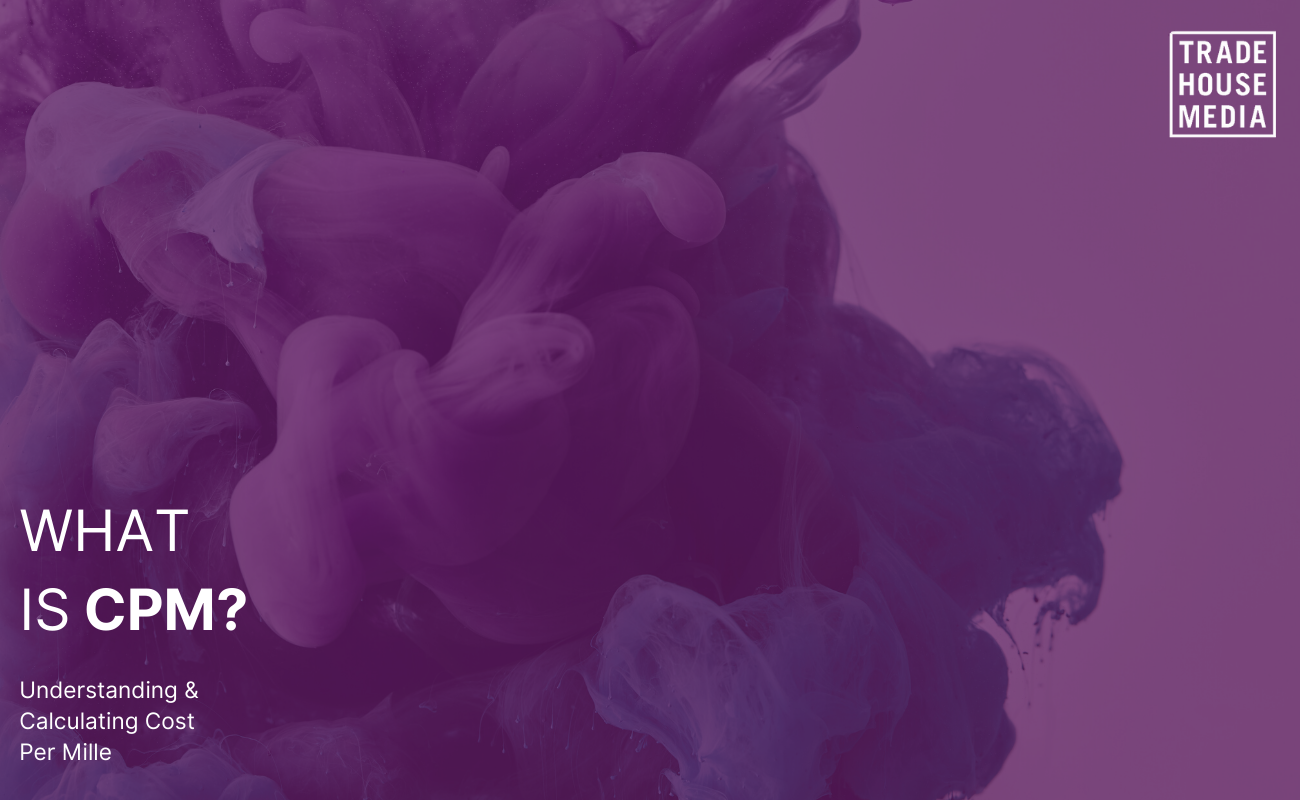
7 min read
What is CPM?
What is CPM? Trade House Media Outline the Basics of CPM & Calculating Cost Per Mille for Advertisers & Publishers.
CPM or ‘Cost Per Mille’ is a key advertising metric that is used by advertisers and publishers to measure the cost per thousand impressions.
In simple terms, CPM refers to the price that advertisers must pay publishers to put their content in front of users. For example, if a publisher charges £3.00 CPM, then an advertiser must pay £3.00 every time their advertisement is displayed to 1,000 users.
How Can I Calculate CPM Cost?
Calculating Cost Per Mille is simple. Given that CPM is the cost per thousand impressions, simply divide the cost by the number of impressions and then divide that number by one thousand. Therefore the CPM formula is CPM = CPM = 1000 * cost / impressions. It is also worth noting the following two CPM formulas: 1. To calculate the cost (the amount advertisers need to pay publishers): cost = CPM * impressions / 1000 2. To calculate impressions (the number of impressions you can expect to receive with your budget): impressions = 1000 * cost / CPM Can’t be bothered whipping out your calculator? Use our free CPM calculator below to quickly calculate your advertising CPM. [CP_CALCULATED_FIELDS id="8"]What Is a Good CPM?
Determining a good CPM or an ideal campaign CPM is almost impossible without considering all of the variables at play. Advertisers should review past advertising performance, industry-relevant advertising data, and advertising ROI to determine a goal or benchmark CPM for their advertising campaigns. As with most online advertising, it takes time to accrue enough data to understand the efficacy of your campaigns. Running multiple campaigns across different websites, with different advertising campaigns means that you can collect more data and make better advertising decisions. A general rule of thumb to remember for CPM is that lower is not always better. In many cases, a lower CPM may mean lower quality traffic and poor conversion rates. Conversely, a high CPM does not automatically equal high-quality leads and conversions. CPM is just one (of many) metrics that advertisers should be considering for online campaigns.
What is an Impression?
An impression is a metric used by publishers and advertisers to quantify the number of digital views that a piece of content receives. Counting impressions is an important metric for publishers and advertisers as it enables them to measure how many times their content has been displayed to users. It is important to note that reach and impressions, two terms that are often used interchangeably by advertisers, are not the same thing. Reach refers to the total number of people who see your content, whereas impressions refer to the total number of times that your content is displayed – irrespective of whether the user viewed the advertisement.
In a broader sense, impressions allow publishers and advertisers to quantify the efficacy of ad placement and measure other metrics such as Click-Through-Rates (CTR) from different advertising channels.

Why is CPM an Important Metric?
One of the biggest advantages of digital advertising compared to traditional media is the ease at which advertisers can analyse, compare, and refine campaigns based on data. With the right data, and the expertise to interpret and analyse exactly what it means, advertisers can accurately measure the efficacy of their online advertising campaigns. By monitoring CPM, advertisers will be able to assess ad performance for every thousand impressions and take specific actions to improve visibility. In order to maximise CPM (and advertising budget), it’s important to understand the factors that drive CPM and optimise accordingly. For publishers, there is a unique set of factors to consider when determining the CPM rates for ads. While it may be tempting to set a higher CPM, it is important to consider variables like industry, seasonality, and past performance to ensure you are attracting the right kind of advertisers.What Are the Factors that Influence CPM?
There is a myriad of factors that have an impact on the value of CPM for advertisers and publishers. Here are some of the most important factors to consider when reviewing CPM:
User Location
The location in which ads are being served correlates closely with the country in which they are being served. For instance, an ad served in a country with a high GDP like Switzerland will almost invariably cost more than an advertisement served in a country with a very low GDP.
Generally speaking, ads served in high-GDP, English-speaking countries tend to attract a higher CPM than ads served in other countries.
Device Type
Device type can have a significant impact on the cost per CPM for advertisers and publishers. In general, ads that are served on mobile devices will have a lower CPM than ads that are served on desktop devices due to screen size limitations, lower CTR, and lower overall conversion rates. While mobile and tablet devices eclipsed desktops back in 2016, the value of mobile traffic is still lower than desktop devices. Due to a myriad of user experience and user interface factors, users are still more likely to transact from desktop devices - which means a higher CPM for advertisers. In some cases, advertisers may choose to pay a premium CPM to users on certain devices. If they identify that users on Apple Mobile Devices have a higher conversion rate than those searching from an Android or Desktop, they may choose to pay a premium CPM to reach these users.Ad Size
In a world where advertisers are competing for the attention of users, larger ad formats attract a higher CPM than small ads. Advertisers have identified the following optimal ad size on mobile devices to be:- 720×90 (Leader board)
- 300×600 (Half Page Size)
- 320×100 (Mobile Banner)
- 300×250 (Square)
